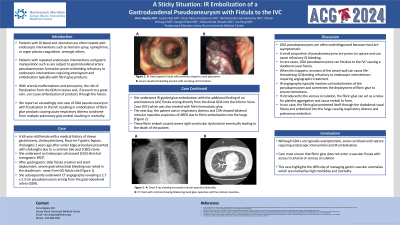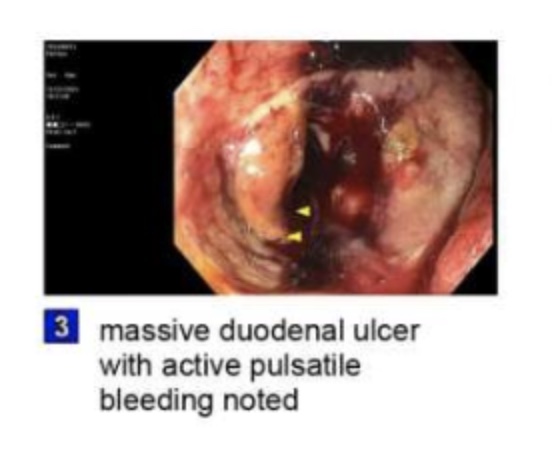Monday Poster Session
Category: GI Bleeding
P2478 - A Sticky Situation: Gastroduodenal pseudoaneurysm with fistula to the IVC
Monday, October 28, 2024
10:30 AM - 4:00 PM ET
Location: Exhibit Hall E

Has Audio

Vera Hapshy, DO
Jersey Shore University Medical Center
Marlboro, NJ
Presenting Author(s)
Vera Hapshy, DO1, Lauren Klei, MD2, Anne Marie Arcidiacono, DO2, Harshavardan Sannekommu, MD2, Steven Imburgio, MD2, Swapnil Patel, MD2, Mohammad Hossain, MD2, Lee Peng, MD, PhD3
1Jersey Shore University Medical Center, Marlboro, NJ; 2Jersey Shore University Medical Center, Neptune, NJ; 3Jersey Shore University Medical Center, Neptune City, NJ
Introduction: Patients undergoing repeated endoscopic procedures and gastric manipulations are at risk for gastroduodenal artery (GDA) pseudoaneurysm formation, leading to bleeding that may require embolization with fibrin glue. Pseudoaneurysms increase the risk of fistulization from the GDA with possible embolization of products into the pulmonary circulation. We report a rare case of a GDA pseudoaneurysm with fistulization to the inferior vena cava (IVC) treated with fibrin glue resulting in embolization, acute respiratory distress syndrome (ARDS), and subsequent mortality.
Case Description/Methods: A 63-year-old female with a history of sleeve gastrectomy, cholecystectomy, Roux-en-Y gastric bypass, and cholangitis presented with cholangitis due to a common bile duct (CBD) stone. She underwent an endoscopic ultrasound (EUS)-directed transgastric ERCP. After the creation of a gastrogastric (GG) fistula and stent deployment, severe GI bleeding was noted in the duodenum, away from the GG fistula site. CT angiography revealed a 2.7 x 2.3 cm pseudoaneurysm from the GDA. She underwent interventional radiology (IR)-guided glue embolization, which showed an arteriovenous (AV) fistula from the distal GDA into the IVC, treated with fibrin hemostatic glue. The next day, the patient experienced respiratory distress, and a chest x-ray showed bilateral reticular opacities indicating ARDS due to fibrin embolization into the lungs. These emboli caused severe right ventricular dysfunction, eventually leading to her death.
Discussion: GDA pseudoaneurysms are often underdiagnosed due to their asymptomatic nature, occurring in patients with surgical or endoscopic manipulation. A small proportion may rupture, causing GI bleeding. Rarely, GDA pseudoaneurysms fistulize to the IVC, forming a duodenal-caval fistula. This can cause life-threatening GI bleeding, requiring angiographic intervention. IR angiography usually involves coil embolization and fibrin glue to ensure hemostasis. If fibrin glue enters the venous circulation, it can cause emboli formation. In our case, fibrin glue entered through the duodenal-caval fistula and embolized into the lungs, causing respiratory distress and pulmonary embolism. This complication has been reported in gastric variceal treatment with sclerotherapy but is rare as an angiographic complication. This case underscores the challenge of managing gastric vascular anomalies, which are associated with high morbidity and mortality.

Disclosures:
Vera Hapshy, DO1, Lauren Klei, MD2, Anne Marie Arcidiacono, DO2, Harshavardan Sannekommu, MD2, Steven Imburgio, MD2, Swapnil Patel, MD2, Mohammad Hossain, MD2, Lee Peng, MD, PhD3. P2478 - A Sticky Situation: Gastroduodenal pseudoaneurysm with fistula to the IVC, ACG 2024 Annual Scientific Meeting Abstracts. Philadelphia, PA: American College of Gastroenterology.
1Jersey Shore University Medical Center, Marlboro, NJ; 2Jersey Shore University Medical Center, Neptune, NJ; 3Jersey Shore University Medical Center, Neptune City, NJ
Introduction: Patients undergoing repeated endoscopic procedures and gastric manipulations are at risk for gastroduodenal artery (GDA) pseudoaneurysm formation, leading to bleeding that may require embolization with fibrin glue. Pseudoaneurysms increase the risk of fistulization from the GDA with possible embolization of products into the pulmonary circulation. We report a rare case of a GDA pseudoaneurysm with fistulization to the inferior vena cava (IVC) treated with fibrin glue resulting in embolization, acute respiratory distress syndrome (ARDS), and subsequent mortality.
Case Description/Methods: A 63-year-old female with a history of sleeve gastrectomy, cholecystectomy, Roux-en-Y gastric bypass, and cholangitis presented with cholangitis due to a common bile duct (CBD) stone. She underwent an endoscopic ultrasound (EUS)-directed transgastric ERCP. After the creation of a gastrogastric (GG) fistula and stent deployment, severe GI bleeding was noted in the duodenum, away from the GG fistula site. CT angiography revealed a 2.7 x 2.3 cm pseudoaneurysm from the GDA. She underwent interventional radiology (IR)-guided glue embolization, which showed an arteriovenous (AV) fistula from the distal GDA into the IVC, treated with fibrin hemostatic glue. The next day, the patient experienced respiratory distress, and a chest x-ray showed bilateral reticular opacities indicating ARDS due to fibrin embolization into the lungs. These emboli caused severe right ventricular dysfunction, eventually leading to her death.
Discussion: GDA pseudoaneurysms are often underdiagnosed due to their asymptomatic nature, occurring in patients with surgical or endoscopic manipulation. A small proportion may rupture, causing GI bleeding. Rarely, GDA pseudoaneurysms fistulize to the IVC, forming a duodenal-caval fistula. This can cause life-threatening GI bleeding, requiring angiographic intervention. IR angiography usually involves coil embolization and fibrin glue to ensure hemostasis. If fibrin glue enters the venous circulation, it can cause emboli formation. In our case, fibrin glue entered through the duodenal-caval fistula and embolized into the lungs, causing respiratory distress and pulmonary embolism. This complication has been reported in gastric variceal treatment with sclerotherapy but is rare as an angiographic complication. This case underscores the challenge of managing gastric vascular anomalies, which are associated with high morbidity and mortality.

Figure: Duodenal Ulcer with active pulsatile bleeding
Disclosures:
Vera Hapshy indicated no relevant financial relationships.
Lauren Klei indicated no relevant financial relationships.
Anne Marie Arcidiacono indicated no relevant financial relationships.
Harshavardan Sannekommu indicated no relevant financial relationships.
Steven Imburgio indicated no relevant financial relationships.
Swapnil Patel indicated no relevant financial relationships.
Mohammad Hossain indicated no relevant financial relationships.
Lee Peng indicated no relevant financial relationships.
Vera Hapshy, DO1, Lauren Klei, MD2, Anne Marie Arcidiacono, DO2, Harshavardan Sannekommu, MD2, Steven Imburgio, MD2, Swapnil Patel, MD2, Mohammad Hossain, MD2, Lee Peng, MD, PhD3. P2478 - A Sticky Situation: Gastroduodenal pseudoaneurysm with fistula to the IVC, ACG 2024 Annual Scientific Meeting Abstracts. Philadelphia, PA: American College of Gastroenterology.
